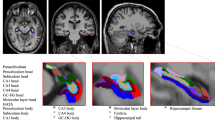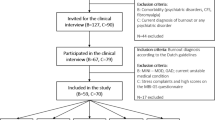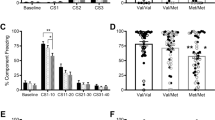Abstract
The brain-derived neurotrophic factor (BDNF) gene is critical for neuronal function and survival, and is likely to be important in psychiatric disorders. In this study, we used single-nucleotide polymorphism (SNP) discovery, functional analyses, and genetic association studies to better understand the potential role of BDNF sequence variation in behavior. Screening 480 unrelated individuals for SNPs and genotyping was performed in US Caucasian, American Indian, and African American populations. Lifetime DSM-III-R psychiatric diagnoses were assigned and the Tridimensional Personality Questionnaire (TPQ) was administered to measure anxious temperament (harm avoidance (HA)) and novelty seeking (NS). A novel SNP (−281 C>A) in promoter 1 was discovered that had decreased DNA binding in vitro and decreased basal reporter gene activity in transfected rat hippocampal neurons. The frequency of the −281 A allele was 0.03 in a Caucasian sample, but was virtually absent in other populations. Association analyses in a community-based sample showed that individuals with the −281 A allele (13 heterozygotes) had lower TPQ HA (F=4.8, p<0.05). In contrast, the Met 66 allele was associated with increased HA (F=4.1, p=0.02) and was most abundant in individuals with both anxiety disorders and major depression (p<0.05). Among the Val66Val homozygotes, individuals who were –281 CA heterozygotes had significantly lower HA than the –281 CC homozygotes (p<0.01). Our results suggest that in this population, the low activity –281 A allele may be protective against anxiety and psychiatric morbidity, whereas Met 66 may be a risk allele.
Similar content being viewed by others
Log in or create a free account to read this content
Gain free access to this article, as well as selected content from this journal and more on nature.com
or
References
American Psychiatric Association (1987). Diagnostic and Statistical Manual of Mental Disorders, 3rd edn, revised. American Psychiatric Association: Washington, DC. 567pp.
Chen Z-Y, Patel PD, Sant G, Meng C-X, Teng KK, Hempstead BL et al (2004). Variant brain-derived neurotrophic factor (BDNF) (Met66) alters the intracellular trafficking and activity-dependent secretion of wild-type BDNF in neurosecretory cells and cortical neurons. J Neurosci 24: 4401–4411.
Chourbaji S, Hellweg R, Brandis D, Zorner B, Zacher C, Lang UE et al (2004). Mice with reduced brain-derived neurotrophic factor expression show decreased choline acetyltransferase activity, but regular brain monoamine levels and unaltered emotional behavior. Brain Res Mol Brain Res 121: 28–36.
Cloninger CR (1987). A systematic method for clinical description and classification of personality variants. Arch Gen Psychiatry 44: 573–788.
Corder EH, Saunders AM, Strittmatter WJ, Schmechel DE, Gaskell PC, Small GW et al (1993). Gene dose of apolipoprotein E type 4 allele and the risk of Alzheimer's disease in late onset families. Science 261: 921–923.
Coyle JT, Duman RS (2003). Finding the intracellular signaling pathways affected by mood disorder treatments. Neuron 38: 157–160.
Devlin B, Risch N (1995). A comparison of linkage disequilibrium measures for fine-scale mapping. Genomics 29: 311–322.
Egan MF, Goldberg TE, Kolachana BS, Callicott JH, Mazzanti CH, Straub RE et al (2001). Effect of COMT Val108/158 Met genotype on frontal lobe function and risk for schizophrenia. Proc Natl Acad Sci USA 98: 6917–6922.
Egan MF, Kojima M, Callicott JH, Goldberg TE, Kolachana BS, Bertolino A et al (2003). The BDNF val66met polymorphism affects activity-dependent secretion of BDNF and human memory and hippocampal function. Cell 112: 257–269.
Endicott J, Spitzer RL (1978). A diagnostic interview: the Schedule for Affective Disorders and Schizophrenia. Arch Gen Psychiatry 35: 837–844.
Enoch M-A, White K, Harris CR, Robin RW, Ross J, Rohrbaugh JW et al (1999). Association of low-voltage alpha EEG with a subtype of alcohol use disorders. Alcohol Clin Exp Res 23: 1312–1319.
Geller B, Badner JA, Tillman R, Christian SL, Bolhofner K, Cook Jr EH (2004). Linkage disequilibrium in the brain-derived neurotrophic factor Val66Met polymorphism in children with a prepubertal and early adolescent bipolar disorder phenotype. Am J Psychiatry 161: 1698–1700.
Hall D, Dhilla A, Charalambous A, Gogos JA, Karayiorgou M (2003). Sequence variants of the brain-derived neurotrophic factor (BDNF) gene are strongly associated with obsessive–compulsive disorder. Am J Hum Genet 73: 370–376.
Hong CJ, Huo SJ, Yen FC, Tung CL, Pan GM, Tsai SJ (2003). Association study of a brain-derived neurotrophic-factor genetic polymorphism and mood disorders, age of onset and suicidal behavior. Neuropsychobiology 48: 186–189.
Kovalchuk Y, Hanse E, Kafitz KW, Konnerth A (2002). Postsynaptic induction of BDNF-mediated long-term potentiation. Science 295: 1729–1734.
Lipsky RH, Xu K, Zhu D, Kelly C, Terhakopian A, Novelli A et al (2001). NF-κB is a critical determinant in NMDA receptor-mediated neuroprotection. J Neurochem 78: 254–264.
Lynch MA (2004). Long-term potentiation and memory. Physiol Rev 84: 87–136.
MacQueen GM, Ramakrishnan K, Croll SD, Siuciak JA, Yu G, Young LT et al (2001). Performance of heterozygous brain-derived neurotrophic factor knockout mice on behavioral analogues of anxiety, nociception, and depression. Behav Neurosci 115: 1145–1153.
Manji HK, Quiroz JA, Sporn J, Payne JL, Denicoff KA, Gray N et al (2003). Enhancing neuronal plasticity and cellular resilience to develop novel, improved therapeutics for difficult-to-treat depression. Biol Psychiatry 53: 707–742.
Marini AM, Jiang X, Wu X, Tain R, Zhu D, Okagaki P et al (2004). Brain-derived neurotrophic factor and NF-κB: from genes to phenotype. Restor Neurol Neurosci 22: 121–130.
Marini AM, Rabin SJ, Lipsky RH, Mocchetti I (1998). Activity-dependent release of brain-derived neurotrophic factor underlies the neuroprotective effect of N-methyl-D-aspartate. J Biol Chem 273: 29394–29399.
Mattson MP, Zhang Y, Bose S (1993). Growth factors prevent mitochondrial dysfunction, loss of calcium homeostasis, and cell injury, but not ATP depletion in hippocampal neurons deprived of glucose. Exp Neurol 121: 1–13.
Messaoudi E, Ying SW, Kanhema T, Croll SD, Bramham CR (2002). Brain-derived neurotrophic factor triggers transcription-dependent, late phase long-term potentiation in vivo. J Neurosci 22: 7453–7461.
Murphy DL, Lerner A, Rudnick G, Lesch KP (2004). Serotonin transporter: gene, genetic disorders, and pharmacogenetics. Mol Interv 4: 109–123.
Murray KD, Hayes VY, Gall CM, Isackson PJ (1998). Attenuation of the seizure-induced expression of BDNF mRNA in adult rat brain by an inhibitor of calcium/calmodulin-dependent protein kinases. Eur J Neurosci 10: 377–387.
Nakagawa S, Kim J-E, Lee R, Malberg JE, Chen J, Steffen C et al (2002). Regulation of neurogenesis in adult mouse hippocampus by cAMP and the cAMP response element-binding protein. J Neurosci 22: 3673–3682.
Nakata K, Ujike H, Sakai A, Uchida N, Nomura A, Imamura T et al (2003). Association study of the brain-derived neurotrophic factor (BDNF) gene with bipolar disorder. Neurosci Lett 337: 17–20.
Neves-Pereira M, Mundo E, Muglia P, King N, Macciardi F, Kennedy JL (2002). The brain-derived neurotrophic factor gene confers susceptibility to bipolar disorder: evidence from a family-based association study. Am J Hum Genet 71: 651–655.
Prestridge DS (1991). SIGNAL SCAN: a computer program that scans DNA sequences for eukaryotic transcriptional elements. Comput Appl Biosci 7: 203–206.
Ribases M, Gratacos M, Armengol L, de Cid R, Badia A, Jimenez L et al (2003). Met66 in the brain-derived neurotrophic factor (BDNF) precursor is associated with anorexia nervosa restrictive type. Mol Psychiatry 8: 745–751.
Rudolph JG, White S, Sokolsky C, Bozak D, Mazzanti C, Lipsky RH et al (2002). Determination of melting temperature for variant detection using dHPLC: a comparison between an empirical approach and DNA melting prediction software. Genet Test 6: 169–176.
Rumajogee P, Madeira A, Vergé D, Hamon M, Miquel M-C (2002). Up-regulation of the neuronal serotoninergic phenotype in vitro: BDNF and cAMP share Trk B-dependent mechanisms. J Neurochem 83: 1525–1528.
Saarelainen T, Hendolin P, Lucas G, Koponen E, Sairanen M, MacDonald E et al (2003). Activation of the TrkB neurotrophin receptor is induced by antidepressant drugs and is required for antidepressant-induced behavioral effects. J Neurosci 23: 349–357.
Schulze TG, Hardy J, McMahon FJ (2003). Inconsistent designs of association studies: a missed opportunity. Mol Psychiatry 8: 770–772.
Sen S, Nesse RM, Stoltenberg SF, Li S, Gleiberman L, Chakravarti A et al (2003). A BDNF coding variant is associated with the NEO personality inventory domain neuroticism, a risk factor for depression. Neuropsychopharmacology 28: 397–401.
Sklar P, Gabriel SB, McInnis MG, Bennett P, Lim YM, Tsan G et al (2002). Family-based association study of 76 candidate genes in bipolar disorder: BDNF is a potential risk locus. Mol Psychiatry 7: 579–593.
Tabuchi A, Nakaoka R, Amano K, Yukimine M, Andoh T, Kuraishi Y et al (2000). Differential activation of brain-derived neurotrophic factor gene promoters I and III by Ca2+ signals evoked via L-type voltage-dependent and N-methyl-D-aspartate receptor Ca2+ channels. J Biol Chem 275: 17269–17275.
Tabuchi A, Sakaya H, Kisukeda T, Fushiki H, Tsuda M (2002). Involvement of an upstream stimulatory factor as well as cAMP-responsive element-binding protein in the activation of brain-derived neurotrophic factor gene promoter I. J Biol Chem 277: 35920–35931.
Tao X, Finkbeiner S, Arnold DB, Shaywitz AJ, Greenberg ME (1998). Ca2+ influx regulates BDNF transcription by a CREB family transcription factor-dependent mechanism. Neuron 20: 709–726.
Tao X, West AE, Chen WG, Corfas G, Greenberg ME (2002). A calcium-responsive transcription factor, CaRF, that regulates neuronal activity-dependent expression of BDNF. Neuron 33: 383–395.
Toda T, Momose Y, Murata M, Tamiya G, Yamamoto M, Hattori N et al (2003). Toward identification of susceptibility genes for sporatic Parkinson's disease. J Neurol Suppl 3: III40–III43.
Tsai SJ, Hong CJ, Yu YW, Chen TJ (2004). Association study of a brain-derived neurotrophic factor (BDNF) Val66Met polymorphism and personality trait and intelligence in healthy young females. Neuropsychobiology 49: 13–16.
Tsuang MT, Taylor L, Faraone SV (2004). An overview of the genetics of psychotic mood disorders. J Psychiatr Res 38: 3–15.
Xu B, Gottschalk W, Chow A, Wilson RI, Schnell E, Zang K et al (2000). The role of brain-derived neurotrophic factor receptors in the mature hippocampus: modulation of long-term potentiaton through a presynaptic mechanism involving TrkB. J Neurosci 20: 6888–6897.
Yan Q, Radeke MJ, Matheson CR, Talvenheimo J, Welcher AA, Feinstein SC (1997). Immunocytochemical localization of TrkB in the central nervous system of the adult rat. J Comp Neurol 378: 135–157.
Acknowledgements
This work was funded by intramural research grant Z01-AA00325 from the National Institute on Alcohol Abuse and Alcoholism, National Institutes of Health (RHL) and by grant F292BU from the Defense Brain and Spinal Cord Injury Program (AMM).
Author information
Authors and Affiliations
Corresponding author
Rights and permissions
About this article
Cite this article
Jiang, X., Xu, K., Hoberman, J. et al. BDNF Variation and Mood Disorders: A Novel Functional Promoter Polymorphism and Val66Met are Associated with Anxiety but Have Opposing Effects. Neuropsychopharmacol 30, 1353–1361 (2005). https://doi.org/10.1038/sj.npp.1300703
Received:
Revised:
Accepted:
Published:
Issue date:
DOI: https://doi.org/10.1038/sj.npp.1300703
Keywords
This article is cited by
-
The role of neurotrophic factors in novel, rapid psychiatric treatments
Neuropsychopharmacology (2024)
-
Behavioral phenotyping of a rat model of the BDNF Val66Met polymorphism reveals selective impairment of fear memory
Translational Psychiatry (2022)
-
SLC1A3 C3590T but not BDNF G196A is a predisposition factor for stress as well as depression, in an adolescent eastern Indian population
BMC Medical Genetics (2020)
-
Early-life stress alters affective behaviors in adult mice through persistent activation of CRH-BDNF signaling in the oval bed nucleus of the stria terminalis
Translational Psychiatry (2020)
-
Sex differences in neural mechanisms mediating reward and addiction
Neuropsychopharmacology (2019)



